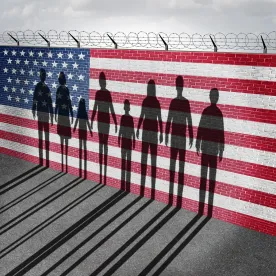Canada will see a great deal more asylum applications this year as the Trump Administration shows signs of tightening U.S. asylum procedures. Asylum seekers to the U.S. face about a 50-50 chance of rejection after President Donald Trump issued his Executive Order on Border Security and Immigration Enforcement Improvements (EO), however, getting to the hearing stage may be even less likely.
The Administration’s asylum policies are clear. Section 11 of the EO states: “It is the policy of the executive branch to end the abuse of parole and asylum provisions currently used to prevent the lawful removal of removable aliens.” Additionally, Section 6 terminates “the practice commonly known as ‘catch and release,’ whereby aliens are routinely released in the United States shortly after their apprehension for violations of immigration law.”
When an individual comes to the U.S. border seeking asylum, CBP refers that individual for an interview with an asylum officer for a “credible fear” determination. In the wake of the EO, it has been reported that, in some cases, CPB is not making that referral and individuals are denied access to the process. It has also been reported that even those who successfully file asylum applications are denied bond or parole as they await hearings. This frustrates the individual’s ability to seek counsel and to prepare the proof needed to prevail at an asylum hearing.
The EO also has made its way into training materials for U.S. asylum adjudicators. In the past, if an asylum officer had “reasonable doubt” about an individual’s credibility, the officer erred in favor of a finding of “credible fear,” allowing a hearing. Government training materials now direct officers to err in favor of removal. In addition, while recognizing cultural factors can affect an applicant’s demeanor, officers are told not to consider those as “significant factors” when assessing credibility.
Notwithstanding the perception that asylum claims in Canada may have a higher likelihood of success compared to claims in the U.S., there is no shortage of difficulty for an applicant to Canada. Because physical presence at the Canadian border is necessary to assert the asylum claim, the route to Canada often is through the U.S. Under the 2005 Canada-U.S. Safe Third Country Agreement, however, refugees must seek asylum in the first country they enter. Therefore, refugees who make it to the U.S. are not eligible for asylum in Canada unless they have a Canadian “anchor relative,” is an unaccompanied minor, has Canadian documentation, or (under a public interest exception) could be subject to the death penalty in the U.S. or elsewhere. Some refugees, therefore, are in limbo. With no status in the U.S., many are attempting to avoid removal by making perilous journeys to Canada. The extraordinary story of this “New Underground Railroad” has been documented by Jake Halpern in his March 13, 2017, The New Yorker article.




 />i
/>i
